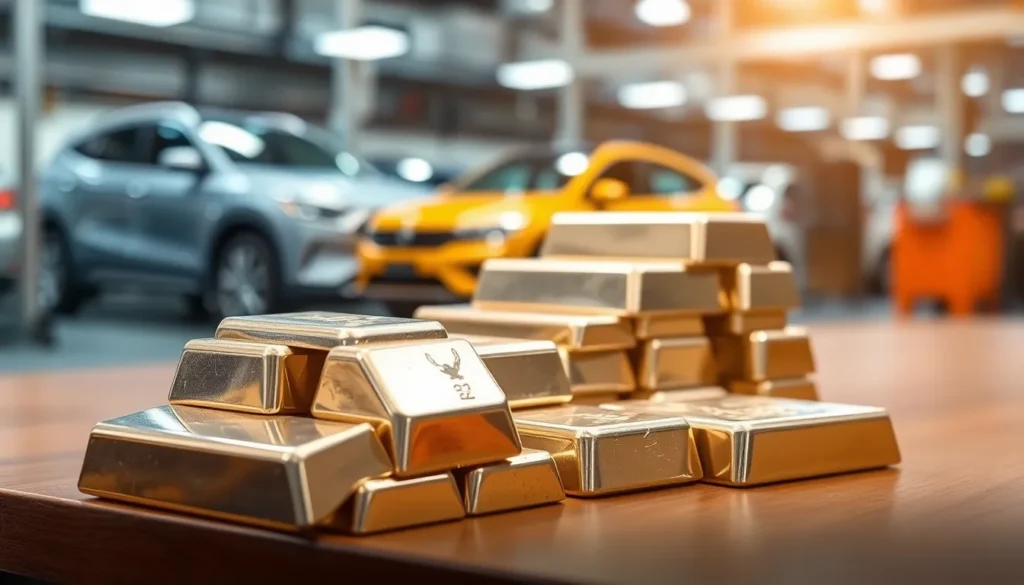In the world of precious metals, palladium often plays the role of the quirky underdog, overshadowed by its more famous cousins like gold and silver. But don’t let its lesser-known status fool you; this shiny metal is making waves in the investment pool. With its skyrocketing demand in the automotive industry and limited supply, palladium is turning heads and raising eyebrows.
Is Palladium a Good Investment
Palladium plays a critical role in the precious metals market, often overshadowed by gold and silver. Increasingly, investors recognize palladium as a viable alternative due to its remarkable properties and applications. The automotive sector remains its primary consumer, utilizing palladium in catalytic converters to reduce harmful emissions. This specific demand has surged, particularly as global regulations on vehicle emissions tighten.
Limited supply significantly influences palladium’s market dynamics. Major producers include Russia and South Africa, which collectively account for over 75% of global output. Mining disruptions and geopolitical tensions often impact availability, driving prices higher. Recent years have seen substantial price increases, reflecting both rising demand and constrained supply.
Investors interested in diversifying their portfolios look to palladium for its potential benefits. Its price movements frequently differ from those of gold and silver, offering a hedge during times of economic uncertainty. Additionally, the industrial uses of palladium extend beyond automotive applications, including electronics and dentistry, enhancing its investment appeal.
Market analysts note the volatility associated with palladium, indicating that while it presents opportunities, it also carries risks. Awareness of these factors can help investors make informed decisions regarding their investments in palladium. Keeping an eye on industry trends and regulatory changes remains crucial as these elements shape the future of palladium in the market.
Current Market Trends

Palladium’s market continues to evolve, driven by various economic factors and industry developments.
Price Fluctuations
Prices for palladium experienced significant volatility recently. Rapid increases have occurred in response to soaring demand and constrained supply. For instance, prices surged by over 30% in 2020, a reflection of heightened interest in reducing vehicle emissions. Sharp corrections followed, demonstrating the inherent unpredictability. Analysts suggest that market reactions can shift quickly based on geopolitical tensions or mining disruptions, underscoring the need for due diligence. Many investors monitor these fluctuations, viewing them as both a risk and an opportunity within their investment strategies.
Demand and Supply Dynamics
Growing demand for palladium correlates strongly with the automotive sector’s shift toward greener technologies. Catalytic converters utilize palladium to lower harmful emissions, creating a surge in consumption. The automotive industry’s transition to electric vehicles also impacts future demand projections. Limited supply complicates the landscape, as Russia and South Africa contribute over 75% to global production. Disruptions in these regions can tighten availability, further affecting prices. Monitoring these dynamics remains essential for investors, enabling informed decisions in the palladium market.
Factors Affecting Investment Potential
Palladium’s investment potential hinges on various factors that influence its market dynamics. Understanding these elements can help investors make informed decisions.
Economic Indicators
Economic indicators play a crucial role in determining palladium prices. Growing manufacturing output, particularly within the automotive sector, sparks increased demand for palladium. Inflation rates also affect investor behavior; higher inflation typically leads to a surge in precious metal investments. Interest rates can shift market dynamics as well; lower rates often encourage investment in physical commodities like palladium. Additionally, geopolitical tensions can disrupt supply chains, creating volatility in price movements. Investors should pay attention to these indicators, as they provide insights into potential price fluctuations.
Industrial Uses
Palladium finds its primary application in the automotive industry, where it is essential for catalytic converters that reduce harmful emissions. Over 80% of palladium demand stems from this sector. Beyond automotive, palladium is gaining traction in electronics manufacturing, where it is utilized in connectors and other components. Its role in dentistry as a material for dental alloys further broadens its appeal. The shift toward greener technologies fuels continued growth in these industrial uses, amplifying palladium’s investment allure. Investors can capitalize on these diverse applications to gauge the metal’s market resilience and long-term potential.
Risks and Considerations
Investing in palladium presents certain risks that investors must consider. Understanding these issues enhances decision-making in this volatile market.
Market Volatility
Market volatility characterizes palladium, which can lead to rapid price fluctuations. Prices surged over 30% in 2020, showcasing dramatic responses to demand changes. Investors often witness both sharp increases and significant corrections within short timeframes. Unforeseen events can abruptly alter market dynamics, causing unpredictable reactions. Analysts highlight that geopolitical tensions and supply chain disruptions frequently impact palladium prices. Keeping an eye on market trends is essential for investors to navigate this environment effectively. Long-term investment strategies may require heightened adaptability due to these unpredictable shifts.
Regulatory Factors
Regulatory factors significantly influence palladium’s investment landscape. Government policies regarding emissions control drive demand as they promote cleaner technologies. Stricter vehicle emissions standards lead to increased usage of palladium in catalytic converters. Changes in these regulations can directly impact palladium’s market demand. Conversely, shifts toward electric vehicles may alter the industry’s long-term palladium needs. Investors must stay informed about any relevant regulations that could affect supply and demand dynamics. Regulatory developments can create both opportunities and risks, making continuous monitoring vital for successful investment strategies.
Comparison with Other Precious Metals
Palladium’s investment potential must be evaluated alongside traditional precious metals like gold and silver. Both metals have unique characteristics that can influence investment choices.
Gold
Gold serves as a long-standing safe haven during economic turmoil. Its historical value often provides stability, making it a go-to for risk-averse investors. While palladium’s demand fluctuates with changes in the automotive sector, gold sees consistent demand in jewelry and investment markets. Investors often turn to gold to hedge against inflation and currency fluctuations. The price of gold generally moves inversely to stock markets, offering a diversification strategy that palladium may not always provide.
Silver
Silver, like gold, is recognized as a store of value but comes with its own set of dynamics. Industrial applications, particularly in electronics and renewable energy, drive silver’s demand, distinguishing it from both gold and palladium. Price movements in silver can be more volatile due to its dual role as an investment and industrial commodity. While palladium benefits from the automotive industry’s shift toward cleaner technologies, silver continues to attract attention for its affordability and widespread usage. As such, investors looking for diversification might find value in both silver and palladium, especially when considering market cycles.
Conclusion
Palladium presents a compelling investment opportunity for those looking to diversify their portfolios. Its unique position in the automotive industry and expanding applications in electronics and dentistry enhance its appeal. However the volatility associated with palladium cannot be overlooked. Investors must remain vigilant and adaptable to market shifts driven by geopolitical tensions and regulatory changes.
As demand continues to evolve alongside stricter emissions regulations and the transition to greener technologies careful monitoring of market trends is essential. While palladium may offer potential rewards it also carries inherent risks that require thorough research and strategic planning.



